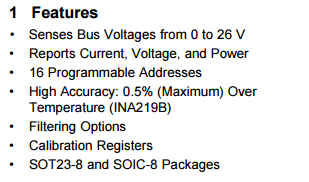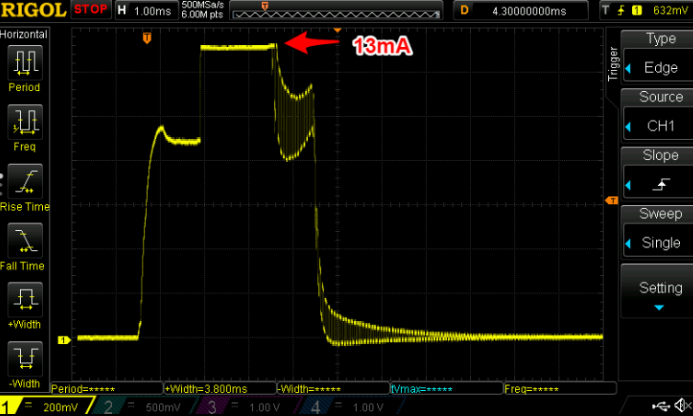@skywatch Take a look at my pan tilt project. A stepper i.s.o. servo can easily be achieved. I would recommend to use the AccelStepper lib to have a smooth movement.
AWI
Posts
-
Pan Tilt stepper motors -
💬 Micro (nano) ampere meter (double)@mfalkvidd the 'local adc' library is the hx711 library which I placed in the sketch folder. Sorry for the confusion
-
Double Micro (nano) Ampere meter@NeverDie @Nca78 a lot going on here :grinning: Nice to see that my afternoon project sparked creativity.
I started this to be a datalogger for remote monitoring of MySensors node power consumption. During the run changed my mind and it turned out to be this which fits my needs. But all options are still open..
The converter has a max sample rate of 80Hz which was default on the board I used. I balanced accuracy and readability by applying sample averaging. This averages out much of the noise from USB source etc.
The sparkfun boards are probably designed a little different and don't have the shield which helps to keep out noise.
To increase speed you can change the amount of averaging (number of readings per sample)
To get a better response for the button the way is to go for non blocking (averaging) readings of the Adc. The library is very basic so that would be the best place to start. -
nRf24L01+ connection quality meter@dakipro It would take a resistor and analog power reading to include basic power measurement. Current would vary between ~3mA and 70mA (with amplified radio).
-
Your workshop :)@core_c Thanks, I missed that ;-)
-
Your workshop :)@gohan I used a kit. There is also a description and suggestions on improvement of the "Chinese clones" in the documentation of the project.
-
Your workshop :)@Yveaux I soldered the thing myself so build quality is .... ;-) The board I received looks to be solid as well as the components.
Accuracy in resistor/ capacitor meaurement is fine (~5% which is also the toleration of the components tested) Semiconductor analysis is enough for me with Fet / Junction transistors as I can determine the most important characteristics (including the pin layout!) which are within 10% of the datasheet. (pins are 100% correct :-)) -
Your workshop :)@gohan said in Your workshop :):
Aren't these devices basically Arduinos? It's written on the title atmega328. If so if we could get our hands on the code, we could make our own 😀
I finally found the place where the Chinese get their code and design for the "Transistortester". It comes from a german site
 a very extensive project. I doubt if I will ever be able to match or even comprehend what they accomplished. :bow:
a very extensive project. I doubt if I will ever be able to match or even comprehend what they accomplished. :bow: -
DC meter for PV ouput measuring and data logging@tailchopper I wonder if you wouldn't be better of on another forum. MySensors provides an infrastructure for home-automation and IoT. If you are not into connecting it to a MySensors ecosystem there are some dedicated PV (power monitoring) forums which probably give you more focussed / better answers. Like Openenergymonitor
-
DC meter for PV ouput measuring and data logging@tailchopper It would depend on the output voltage & current of your PV panel. Up to 26V 3.2A the ina219 is a very convenient all-in-one sensor with I2C interface.

-
Double Micro (nano) Ampere meter@NeverDie said in Double Micro (nano) Ampere meter:
It looks a bit complicated to me
btw. Which part looks complicated? It's just a few resistors attached to an ADC board (and sketch ready) I am curious on how you can build something simpler with the ADS1220 (which seems to be a better ADC if you are able to find it somewhere ;-))
-
Your workshop :)@Jan-Gatzke For MySensor I use it mostly for measuring response times and get a general idea of what is happening timewise. Especially if you have multiple event happening at the same time. Also for getting a grip on low power

it gives a lot of information which would be very hard to measure with any other instrument. (for my other hobby, analog audio design, I couldn't live without it. ;-))
A few considerations:
- It can be rather complicated using a scope in first instance. (a steep learning curve)
- Unless you are just curious and want to educate yourself I would strongly disencourage buying a cheap instrument. Better to study a few manuals of serious > €300 instruments, save a little and buy the thing you need (or can't resist). 10 years ago you had to put down > €1000 for something reasonable.
-
Pump + Relais + Decoupling@Naitsirhc Since you are using the amplified Radio (PA/LNA) with the socket adapter board he decoupling for the radio should be fine. There are a few discussions on the forum on what kind of problems you can encounter.
First suggestion I have is lowering the transmission energy#define RF24_PA_LEVEL RF24_PA_LOWand make sure you have a sufficient supply (not the on-board ldo of the nano or an FTDI adapter). -
Your workshop :)@gohan Be aware that there are quite a few different versions around. The one I posted has a rotary encoder to select and operate the pwm and frequency functions. The perspex casing fits well with the rest of the nerdy testboxes I own (dummy load, power supply, a few function generators, frequencycounter ) All a lot of functionality for very little..
-
Double Micro (nano) Ampere meter@NeverDie that one would work as well. Maybe harder to get and a little more pricy :moneybag:
-
Has anyone made their own lab power supply out of a PSU?@pansen Then you would miss the fun and flexibility ;-) . A good combination of cheap available stuff in combination with (adjustable) linear components is giving me everything I need.
- The ATX fixed voltages (heavily "denoised") for most MySensors and LED stuff (3.3, 5, 12, > 5 Amps)
- An adjustable (and programmable) linear supply (fed by the ATX) like µSupply.
-
💬 Micro (nano) ampere meter (double)@Nca78 Looks good, Hard to say why the response is slow. There is quite some averaging in taking readings from the ADC and I tried to find a right balance between accuracy and response time/ button behaviour. For me it is not spot on but very usable.
You could try to remove some of the averaging to get a better refresh rate. (i.e. the "32" to "8") -
Any parallel interface accellerometers ?@ny51sens I'm curious what kind of application you are looking at. You can take a look at ADXL377 (analog sensor) and use whatever kind of ADC to read parallel at enormous speeds..
-
PIR am312@hek @NeverDie @kontrollable My stupid mistake... :blush: I was referring to this from the datasheet Pir-AS312
-
Any parallel interface accellerometers ?@ny51sens The "standard" alternative would be the SPI (serial) interface. A parallel interface imho would be not very efficient considering the size of the information and relatively low sampling rates of the sensors.
